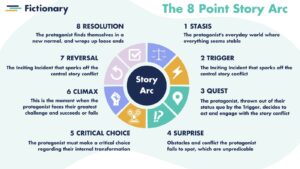
The 8 Point Story Arc was developed by Nigel Watts
Ah, the tangled web of story structure, and the 8 Point Story Arc, versus the 5 Point Story Arc.
When I first dipped my toes into the vast ocean of storytelling, I was about as confused as a chameleon in a bag of Skittles.
Metaphors aside, it’s no secret that understanding story structure can feel like trying to solve a Rubik’s cube in the dark. But then, like a lighthouse cutting through the fog, I discovered Fictionary, and everything clicked into place. Fictionary employs a simple and efficient 5 Point Story Arc that I found intuitive and easy to apply.
But hold your horses, you may ask, “What’s this about an 8 Point Story Arc?”
Excellent question, curious writer. In the vast cosmos of story structure, the 8 Point Story Arc is another constellation that has caught the attention of many a wandering writer. It’s a little more intricate than the 5 Point Arc, a bit like the older, slightly more complicated cousin who knows a lot about 18th century operas.
In this article, we’re going to dissect this 8-legged beast (no, it’s not a spider, promise!) to understand what makes it tick.
Then we’ll put it side by side with our trusty 5 Point Arc to see how they compare.
So, don your literary scuba-diving mask, and prepare for a wild swim through the exciting world of story arcs.
Take a free trial of Fictionary today and take your story to the next level.
Ok, let’s get started!
What is an 8 Point Story Arc?

The plot thickens! I mean, literally. The 8 Point Story Arc is all about adding depth and breadth to your story.
This framework, like a trusty roadmap, provides a set of strategic markers to guide your narrative journey. It’s like the breadcrumbs left by Hansel and Gretel. In our case, we’re not going to get lost or stumble upon any gingerbread houses (unless that’s the genre you’re working with, of course!).
Let’s buckle up and embark on this exciting road trip through the landscape of the 8 Point Story Arc.
You’ve packed your curiosity, right?
Onwards we go.
1. Stasis
Here’s where it all starts, the stasis, or as I like to call it, the “once upon a time” phase.
You set the scene and introduce the characters. Everything is, well, stable (stable, not boring). It’s like the calm before the storm.
We’re invited into the world of the protagonist, learning about their ‘normal’ life. But don’t get too comfortable, because the tranquility won’t last for long. Think of this phase as the canvas on which we will soon paint a vibrant (and sometimes messy) story.
2. Trigger
BOOM!
Did that startle you?
I sure hope so. Because we’re now at the trigger point, the catalyst for the story. Something disrupts the protagonist’s world. That something is the incident. It sparks off the action and gives your protagonist a reason to move out of their comfort zone.
This could be an event, a person, a piece of information, or even a change within the protagonist themselves. A key event has created this ripple, and now the waves form.
3. Quest
Here comes the adventure, the quest. The protagonist decides to act, spurred on by the trigger event.
They start a journey, physical or emotional, to achieve a goal or solve a problem.
This is where they leave behind their old world and step into a new one, filled with challenges, growth, and inevitable transformation. This is where we, as readers, really get to pack our bags and join our hero on their thrilling ride.
4. Surprise
Expect the unexpected.
The surprise stage throws a wrench in the works. It introduces obstacles and complications that the protagonist didn’t foresee.
These twists and turns keep the story engaging and unpredictable, making our hearts skip a beat or two. Who doesn’t love a good plot twist, after all? The surprises not only challenge our protagonist but also reveal more about their character, pushing them to adapt, learn and grow.
5. Critical Choice
To be or not to be, that is the question.
And indeed, our protagonist must answer it in the critical choice phase.
This is where they have to make a decision that will determine the trajectory of the rest of their journey.
The stakes are high. The tension is palpable, and we’re on the edge of our seats. Their choice reflects their values, their transformation so far, and often leads to more profound changes. So, strap in.
The rollercoaster ride is about to get even more thrilling.
6. Climax
Ah, the climax. The crescendo of the symphony, the peak of the mountain climb, the tension that’s been building up. It all finally reaches its breaking point.
The conflict that has been simmering comes to a boil. This is the moment where our protagonist faces their greatest challenge. Their quest culminates here, and there’s no turning back. It’s the point of no return.
7. Reversal
Now, we start the descent.
The reversal phase sees a significant change in the protagonist’s status or situation.
It could be a twist of fortune, a sudden realisation, or a transformation in their character. Things are not the same anymore, and they never will be. The protagonist emerges from the climax, altered. They’ve learned something crucial, either about themselves or their world.
8. Resolution
And finally, the resolution, or the ‘happily ever after’ phase (though it doesn’t always have to be happy, unless you’re writing romance).
The story concludes, wrapping up loose ends.
The protagonist deals with the aftermath of the climax and the consequences of the critical choice. They’re back in a state of stability, but it’s a new normal, shaped by their experiences and growth. It’s time to close the book, but the story lingers, continuing in the hearts of its readers.
Take a free trial of Fictionary today and take your story to the next level.
Why a 5 Point Story Arc Might be Better for Writers
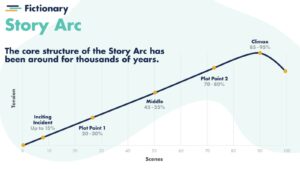
You’re probably familiar with the idea of a three-act structure in storytelling, but have you ever heard of the five-point story arc? No? Then things are about to get interesting. The five-point story arc is a simplified and arguably more intuitive version of the eight-point arc. This lean, mean storytelling machine comprises the following plot points:
- The Inciting Incident
- Plot Point 1
- The Midpoint
- Plot Point 2
- The Climax
It’s like a juicy hamburger, with all the essentials sandwiched between a tasty beginning and a satisfying end.
So, why might the five-point story arc be a better option for writers?
Well, it cuts straight to the chase, eliminating potential fluff, and keeps the story focused on the core conflict and character development. It also ensures a strong narrative flow and maintains tension throughout the story. Plus, its simplicity makes it an ideal starting point for new writers or those working on more compact stories.
A story structured around the five-point arc can still be complex and rich, like a hearty stew that’s been simmering on a low flame. It’s all about how you stir the pot.
Now, let’s delve into each point of the five-point story arc.
1. Inciting Incident
Let’s get the party started with the Inciting Incident.
This is the moment that throws the normal world of your protagonist into a tailspin. It’s the burning letter that arrives via owl, declaring: “Congrats! You’re a wizard, Harry.” Or the peculiar wardrobe that transports Lucy Pevensie into a snowy wonderland.
It’s the catalyst that sets the story rolling down a steep hill. Your protagonist can’t ignore it.
2. Plot Point 1
And here comes Plot Point 1, the proverbial fork in the road.
If the Inciting Incident is the push down the hill, Plot Point 1 is where your protagonist stops tumbling and decides to trek up the mountain. They commit to the journey, the change, the challenge ahead.
Luke Skywalker deciding to join Obi-Wan Kenobi after his aunt and uncle’s death? That’s a classic Plot Point 1.
3. Middle
Ah, the Middle, also known as the wilderness of the story.
This is where an event raises the stakes for the protagonist. It’s also where they shift from a reactive to proactive state.
Until this point, your protagonist has been responding to plot events as they happen. This doesn’t mean they’re passive–because no-one likes a passive character. But it means that after the midpoint, they’ll be less reactive, and take an active role in influencing plot events. They’ll be the one driving the action.
4. Plot Point 2
The Plot Point 2, my friends, is the “oh snap” moment of the story.
This is where the stakes rise to the highest level, the tension is palpable, and the protagonist’s goal seems farther than ever. It’s the big “uh-oh” that makes your reader gasp and drop their bedtime cup of cocoa.
Something bad happens to the protagonist, which brings them down to their lowest moment.
In fantasy and thriller novels, this will be the death of a mentor or friend moment. If romance is your thing, this is the fake break up, where it seems like the couple will never be together again.
That’s Plot Point 2 in all its glory.
5. Climax
Finally, we come to the Climax. The moment we’ve all been waiting for. This is where all the tension, all the drama, and all the conflict hit a head.
It’s the final showdown between your protagonist and their story obstacle (or antagonist). It’s also the resolution of the central conflict.
Remember the moment in “To Kill a Mockingbird” when Scout meets Boo Radley? Or in “Harry Potter and The Deathly Hallows,” when Harry faces Voldemort in their last duel? Those are quintessential climaxes that leave readers breathless, satisfied, and probably in need of a hug.
The Climax is the payoff for all the tension and trouble you’ve been brewing since the Inciting Incident.
It’s the “WOW” in your roller coaster ride of a story. So make it count.
Take a free trial of Fictionary today and take your story to the next level.
Examples of 5 Point Story Arcs from Fiction
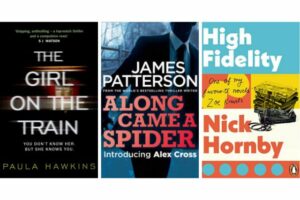
The Girl on the Train by Paula Hawkins
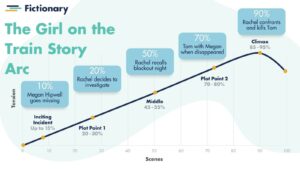
In Paula Hawkins’s “The Girl on the Train,” the 5 point story arc unfolds thrillingly.
The Inciting Incident
The Inciting Incident is when Megan Hipwell goes missing. This kicks Rachel (the protagonist) out of her routine life into a world of intrigue.
Plot Point 1
Plot Point 1 follows when Rachel decides to investigate Megan’s murder. This sets the trajectory of the story into motion.
The Midpoint
The Middle, or Midpoint, arrives when Rachel recalls her blackout night. Until now, Rachel has been reacting to plot events. This pivotal moment makes her more proactive.
Plot Point 2
Plot Point 2 surfaces when she remembers seeing Megan get into her ex-husband, Tom’s car on the night she disappeared. This event escalates the stakes and brings Rachel to her lowest moment.
The Climax
The Climax occurs in a heart-stopping moment when Rachel confronts and fights Tom. He attacks her, and she kills him. Rachel and Anna–Tom’s current wife–agree to claim everything happened in self-defence. This wraps up the central conflict.
Along Came a Spider by James Patterson
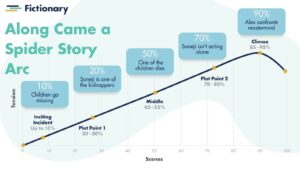
The Inciting Incident
The kidnapping of two high-profile children from their elite school sets the narrative in motion. This presents Alex Cross with the initial problem he needs to solve.
Plot Point 1
Cross’s investigation leads him to a chilling discovery. One kidnapper is a teacher from the school, Gary Soneji. This twist escalates the stakes and gives a personal dimension to Cross’s quest. This is the moment he really becomes invested in the central story conflict.
The Midpoint
The shocking death of one of the kidnapped children marks the midpoint. This moment changes the nature of Cross’s investigation. It’s no longer about rescuing the children. It’s now also about seeking justice. This increases the stakes and makes cross active.
Plot Point 2
Plot Point 2 is when Cross discovers that Soneji isn’t acting alone. There’s an even more sinister plot at play. This deepens the conflict and sets up the climactic parts of the story.
The Climax
The ultimate confrontation between Cross and the mastermind behind the plot brings the story to its climax. It’s where all the tension and conflict in the story come to a head.
High Fidelity by Nick Hornby
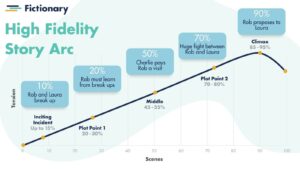
The Inciting Incident
The story kicks off with Rob’s latest breakup with his girlfriend, Laura. This relationship turmoil sets Rob off on his journey of introspection and self-discovery.
Plot Point 1
When Rob decides to revisit his ‘Top Five’ breakups to find out why his love life is a series of disasters, it’s a shift in his perspective. This mission to understand his past mistakes drives the narrative forward.
The Midpoint
Rob’s Midpoint is the unexpected visit from his ex-girlfriend, Charlie. His past confronts him. He realises his nostalgia-tinted memories don’t align with reality. This is a significant turning point in his personal growth. It also forces him from a reactive to active state.
Plot Point 2
Rob has a huge fight with Laura, and his journey of personal growth seems to have failed. This mark’s Rob’s lowest moment.
The Climax
Rob proposes to Laura. He confronts his fear of commitment and vanquishes it. Laura says yes to Rob’s proposal, which resolves the central conflict.
Take a free trial of Fictionary today and take your story to the next level.
Story Arc FAQs

What Happens If My Story Doesn’t Have An Arc?
Well, let’s not mince words here. Without a story arc, your narrative can become as flat as a pancake left under a steamroller.
An arc provides your story with direction, helping to shape character development and establish an interesting plot. If your story lacks an arc, you risk leaving your readers adrift in a sea of random events, with no real investment in your characters’ journeys.
It’s like inviting someone to a party but forgetting to provide the music—sure, the snacks might be great, but where’s the groove?
Isn’t A Story Arc Too Formulaic?
Ah, the age-old debate.
But remember, a formula isn’t a prison, it’s a roadmap.
While a story arc provides a structure, it doesn’t stifle creativity. It can serve as a supportive framework that helps you weave your narrative effectively.
Using a story arc isn’t about following a cookie-cutter approach, but about understanding the rhythm and flow of storytelling. It’s a bit like jazz—once you know the structure, you’re free to improvise and create something uniquely yours.
How Can The Fictionary Software Help With My Story Arc?
Here’s where Fictionary earns its superhero cape. It’s a tool designed specifically to help writers visualise and refine their story’s structure.
With the Fictionary Software, you can do all kinds of things, including:
- Map out your story arc
- Identify weak points in your narrative
- Make informed decisions about how to strengthen your plot
- And more…
It’s like having a GPS for your novel.
It won’t drive the car for you, but it will certainly help you navigate your way to a more interesting story.
Conclusion on the 8 Point Story Arc
Story arcs aren’t about who has the most plot points.
Although the 8 Point Story Arc offers an intriguing perspective, I’ve found that the 5 Point Story Arc tends to be more palatable and manageable for many writers.
Think of it as comparing a sophisticated 8-course gourmet meal to a hearty, satisfying 5-course feast. Yes, the 8-course meal sounds tantalising. But the 5-course dinner can equally satiate your hunger without the feeling of being inundated.
The charm of the 5 Point Story Arc lies in its straightforwardness.
Every point plays a distinct role and fuels the momentum of your story.
It’s less about ticking off a checklist of events and more about ensuring your narrative has the essential elements that engage readers and keep them hooked.
Such elements include:
- An immersive setup
- Engaging conflicts
- A rewarding resolution
And here’s where Fictionary flexes its superpower.
Crafted to streamline the 5 Point Story Arc, Fictionary automatically generates your story arc. This allows you to visualise and fine-tune your story structure in an instinctive, user-friendly manner. Instead of juggling a sprawling web of plot points, you can concentrate on the vital beats of your narrative.
Regardless of whether you’re a plotter or a pantser, using a well-organized story arc coupled with the Fictionary software can revolutionise your writing journey.
So, take the plunge, adopt the 5 Point Arc, and let’s write compelling stories. Fictionary is here to ensure you hit all the right beats.
Take a free trial of Fictionary today and take your story to the next level.


